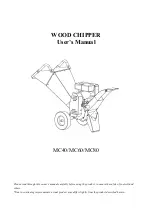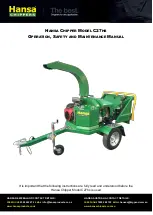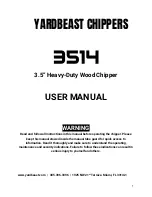
3.6 Installation of damping devices
3.6.1 Damping devices must be provided between the unit
and its foundation.
By means of the
Φ
15mm diameter installation holes on the
steel frame of the unit base, the unit can be fastened on
the foundation through the spring damper. See
Fig.3-
3
(Schematic diagram of installation dimension of the unit)
for details about center distance of the installation holes.
The damper does not go with the unit, and the user can
select the damper according to the relevant requirements.
When the unit is installed on the high roof or the area
sensitive to vibration, please consult the relevant persons
before selecting the damper.
3.6.2 Installation steps of the damper
Step 1. Make sure that the flatness of the concrete
foundation is within ±3mm, and then place the unit on the
cushion block.
Step 2. Raise the unit to the height suitable for installation
of the damping device.
c. Remove the clamp nuts of the damper.
Step 3. Place the unit on the damper, and align the fixing
bolt holes of the damper with the fixing holes on the unit
base.
Step 4. Return the clamp nuts of the damper to the fixing
holes on the unit base, and tighten them into the damper.
Step 5. Adjust the operational height of the damper base,
and screw down the leveling bolts. Tighten the bolts by
one circle to ensure equal height adjustment variance of
the damper.
Step 6. The lock bolts can be tightened after the correct
operational height is reached.
Damping device
Anchor bolt M12
Nut
Ferrol
It is recommended that the damper should be fastened on
the foundation with the provided holes. After the unit is
placed on the foundation, the damper connected with the
unit should not be moved, and the central clamp nut is not
allowed to be tightened before the damper sustains load.
Fig. 3-5
NOTE
4.
WATER SYSTEM INSTALLATION
4.1 Basic requirements of connection of chilled
water pipes
CAUTION
●
After the unit is in place, chilled water pipes can be laid.
●
The relevant installation regulations should be abided with
when conducting connection of water pipes.
●
The pipelines should be free of any impurity, and all chilled
water pipes must conform to local rules and regulations of
pipeline engineering.
●
Connection requirements of chilled water pipes
a. All chilled water pipelines should be thoroughly flushed, to
be free of any impurity, before the unit is operated. Any
impurity should not be flushed to or into the heat exchanger.
b. Water must enter the heat exchanger through the inlet;
otherwise the performance of the unit will decline.
c. The inlet pipe of the evaporator must be provided with a
target flow controller, to realize flow-break protection for the
unit. Both ends of the target flow controller must be supplied
with horizontal straight pipe sections whose diameter is 5
times that of the inlet pipe. The target flow controller must be
installed in strict accordance with “Installation & Regulation
Guide for Target Flow Controller” (Figure 4.3~4.4). The wires
of the target flow controller should be led to the electric
cabinet through shielded cable (see Electric Controlling
Schematic Diagram for details). The working pressure of the
target flow controller is 1.0MPa, and its interface is 1 inch in
diameter. After the pipelines are installed, the target flow
controller will be set properly according to the rated water
flow of the unit.
d. The pump installed in the water pipeline system should be
equipped with starter. The pump will directly press water into
the heat exchanger of the water system.
e. The pipes and their ports must be independently
supported but should not be supported on the unit.
f. The pipes and their ports of the heat exchanger should be
easy to disassemble for operation and cleaning, as well as
inspection of port pipes of the evaporator.
g. The evaporator should be provided with a filter with more
than 40 meshes per inch at site. The filter should be
installed near to the inlet port as much as possible, and be
under heat preservation.
h. The by-pass pipes and by-pass valves as shown in Fig.
4-1 must be mounted for the heat exchanger, to facilitate
cleaning of the outside system of water passage before the
unit is adjusted. During maintenance, the water passage of
the heat exchanger can be cut off without disturbing other
heat exchangers.
i. The flexible ports should be adopted between the interface
of the heat exchanger and on-site pipeline, to reduce
transfer of vibration to the building.
j. To facilitate maintenance, the inlet and outlet pipes should
be provided with thermometer or manometer. The unit is not
equipped with pressure and temperature instruments, so
they need to be purchased by the user.
k. All low positions of the water system should be provided
with drainage ports, to drain water in the evaporator and the
system completely; and all high positions should be supplied
with discharge valves, to facilitate expelling air from the
pipeline. The discharge valves and drainage ports should
not be under heat preservation, to facilitate maintenance.
l. All possible water pipes in the system to be chilled should
be under heat preservation, including inlet pipes and flanges
of the heat exchanger.
Network ON
ć
A
#
#
#
5
O&I manual
Содержание ICHS-600KC-5
Страница 34: ......









































